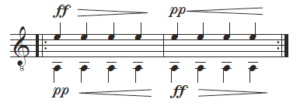Polyphonic basics | how to make voices clear | Part I

In my video/blogs about Single String Etudes I, I repeatedly spoke of rest stroke on melody, free stroke on accompaniment. We discussed the essential rotation of the forearm to aid the angle of fingers so that thumb can play rest stroke easily while the fingers use free stroke, and vice versa. The end was to balance melody and accompaniment and allow the music to sing. But what about when there is no accompaniment, only other melodies! This is called polyphony – multi-voiced. The same techniques can be used to accomplish our goal of two or more independent melodies.
It’s not a mystery
The simple exercise in Part I of this video is the result of many years of pondering the technique of polyphonic playing. It’s not a mystery, it is a skill that can be learned. One that will greatly enhance your musicality and make music more fun to play in general. In this video I discuss how to smoothly and artfully use this technique to create a continuous interplay between voices, one rises while the other falls. The basic exercise is written out in this document along with several musical examples and two original compositions that will be demonstrated in a coming video. Download Polyphonic Exercises and Examples now and get acquainted with the concept and musical examples, which will be presented in Part II.
The technique coming up, but first…
The Back Story
In a guest blog for This Is Classical Guitar, I wrote several years ago about the origins of guitar music:
Where did Narváez’s music come from? Why did he write what he wrote and from what traditions did he emerge? The vihuela de mano repertoire commonly played on the modern guitar is but a tiny portion of the extant repertoire. Seven books by seven different authors contain roughly 700 pieces. Of that, at least half are arrangements (intabulations) of choral repertoire. Most of the rest are fantasías in the choral, or polyphonic style. The few sets of instrumental variations called diferéncias are in fact quite rare and dance music is virtually non-existent.
I was immersed in this music as singer and instrumentalist for 25 years. I developed both a fascination for and deep respect of the music. Much of it is extremely difficult and esoteric by most standards. It is contemplative, and was probably mostly played for the self or a small gathering in a resonant chamber where the soft vihuela could sing robustly and normally short lived notes hung in the air much longer.
A central feature of 16th music is the art of imitation. It is the essence of most large works such as masses and motets by such greats as Josquin des Prez, Palestrina, Gombert, Tallis. And these works are the model for most vihuela repertoire. [The one exception, Luys de Milán, appears to have been less educated in this high art, but, nevertheless, had a flamboyant and effective style of his own.]
An example, the tenor sings a phrase and then the basses sing the exact same relative notes at a different pitch and so on. Even in a choir, if these imitations are not clearly delineated, the piece has little meaning. The dynamic and articulate shaping of the phrase must be nearly identical in all parts.
So how do we do it
Here lies the rub for vihuelists or guitarists playing any such repertoire. How do we make one voice grow (get louder) as another falls (gets softer)? Like this…
 As described in the video, if one uses three combination strokes, all the various dynamic combinations can be accomplished. It is crucial to think only about each individual combination at first, before trying to make music. They are: 1) finger loud rest stroke with thumb soft free stroke; 2) finger and thumb equal free strokes; 3) finger soft free stroke with thumb loud rest stroke.
As described in the video, if one uses three combination strokes, all the various dynamic combinations can be accomplished. It is crucial to think only about each individual combination at first, before trying to make music. They are: 1) finger loud rest stroke with thumb soft free stroke; 2) finger and thumb equal free strokes; 3) finger soft free stroke with thumb loud rest stroke.
 The precise direction of each movement is essential: free strokes are directed slightly upward, away from the string only barely touching it to make a thinner, lighter attack; rest strokes are planted firmly into the rest string in a downward effort to excite the top of the guitar and get not just loud, but solid full tone.
The precise direction of each movement is essential: free strokes are directed slightly upward, away from the string only barely touching it to make a thinner, lighter attack; rest strokes are planted firmly into the rest string in a downward effort to excite the top of the guitar and get not just loud, but solid full tone.
Of course, with growing skill, one can adjust in countless ways to vary angle and timbre, and more subtle gradations of dynamic and attack. The end result is not just a series of unconnected chords, but smooth flowing crescendos and decrescendos at the same time.
Part II will demonstrate this technique in the pieces attached in this document – download Polyphonic Exercises and Examples now and get acquainted with the concept and musical examples.

Recent Comments